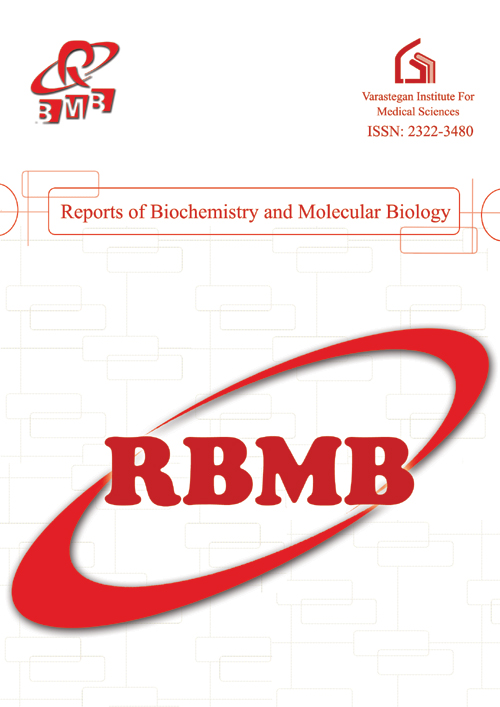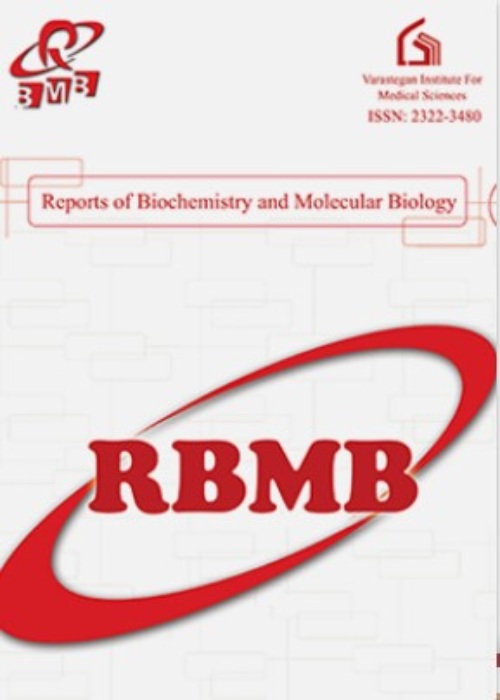فهرست مطالب

Reports of Biochemistry and Molecular Biology
Volume:4 Issue: 1, Oct 2015
- تاریخ انتشار: 1394/02/25
- تعداد عناوین: 7
-
-
Page 1BackgroundThe rapid increase of HIV-1 strains resistant to current antiretroviral drugs is a challenge for successful AIDS therapy. This necessitates the development of novel drugs, and to this end, availability of screening systems for in vitro drug discovery is a priority. Herein, we report the modification of a previously developed system for increased sensitivity, ease of use, and cost-efficiency, based on the application of the EGFP marker.MethodsA PCR-amplified gfp gene (gfp) was cloned into pmzNL4-3, the plasmid already designed to produce single-cycle replicable virions, in frame with the reverse-transcriptase gene to construct the pmzNL4-3/GFP plasmid. GFP-mzNL4-3 pseudo-typed virions, as the first progeny viruses, were recovered from the culture supernatant of HEK293T cells co-transfected with pmzNL4-3/GFP and the helper plasmids pSPAX2 and pMD2G, which respectively encode HIV-1 Gag-Pol and vesicular stomatitis virus glycoprotein. Single-cycle replication and virion production were assessed by syncytia formation, p24 antigen assays, and electron and fluorescence microscopy.ResultsThe incorporation of EGFP into the viral particles allowed their quantification by fluorometry, flow-cytometry, and fluorescence microscopy; however, this modification did not affect the single-round infectivity or production rate of the GFP fluorescence-emitting virions.ConclusionsOur results certify the development of a rapid, inexpensive, and safe GFP-reporting single-cycle replicable system for anti-HIV drug discovery. Further experiments are needed to measure the validity and robustness of the assay.Keywords: HIV, 1, Drug discovery, EGFP, Single, round infection, Fluorometry
-
Page 2BackgroundDegradation of phytic acid to inorganic phosphate in domestic animals’ diets requires thermostable phytase. Although Basillus subtilis phytase shows a potential to be degraded phytate complex in high temperature, the enzyme activities and yields need to be increased to make them possible for industrial application.MethodsThe phytase gene from Bacillus subtilis DR8886 was isolated from Dig Rostam hot mineral spring in Iran and cloned into pET21(+) and pET32(+). Expression was induced with 1.5 mM IPTG and the proteins were purified.ResultsThe recombinant protein affected by thioredoxin (Trx) from pET32a-PhyC was estimated to constitute about 31% of the total soluble protein in the cells; its concentration was 3.5 µg/ml, and its maximal phytase activity was 15.9 U/ml, whereas the recombinant phytase from pET21a-PhyC was estimated to comprise about 19% of the total soluble protein; its concentration was 2.2 µg/ml, and its maximal phytase activity was 69 U/ml. The molecular masses of recombinant phytase with and without Trx were about 60 kDa and 42 kDa, respectively. Zymography confirmed that the recombinant enzymes were active. Although the concentration of the alkaline phytase expressed by pET32a was approximately 59% greater than that expressed by pET21, its phytase activity was approximately 77% less.ConclusionThis study showed that the peripheral gene (Trx) encoded by the pET32a (+) vector are the principal reason for the decrease in recombinant phytase enzyme activity.Keywords: Bacillus subtilis DR8806, PhyC Gene, Thioredoxin
-
Page 3BackgroundRecombinant proteins overexpressed in E. coli are usually deposited in inclusion bodies. Cysteines in the protein contribute to this process. Inter- and intra- molecular disulfide bonds in chitinase, a cysteine-rich protein, cause aggregation when the recombinant protein is overexpressed in E. coli. Hence, aggregated proteins should be solubilized and allowed to refold to obtain native- or correctly- folded recombinant proteins.MethodsDilution method that allows refolding of recombinant proteins, especially at high protein concentrations, is to slowly add the soluble protein to refolding buffer. For thisPurposefirst, the inclusion bodies containing insoluble proteins were purified; second, the aggregated proteins were solubilized; finally, the soluble proteins were refolded using glutathione redox system, guanidinium chloride, dithiothreitol, sucrose, and glycerol, simultaneously.ResultsAfter protein solubilization and refolding, SDS-PAGE showed a 32 kDa band that was recognized by an anti-chitin antibody on western blots.ConclusionBy this method, cysteine-rich proteins from E. coli inclusion bodies can be solubilized and correctly folded into active proteins.Keywords: Chitinase, Cysteine, rich proteins, Protein refolding, Protein solubilization
-
Page 4BackgroundMarine natural products contain a wide range of bioactive compounds with therapeutic properties that have revealed crucial properties in the treatment of some diseases. Some of these compounds have recently received considerable attention for drug discovery. In this study we examined the anti-angiogenic effect of saponin isolated from Holothuria leucospilota (sea cucumber) through evaluation of vascular endothelial growth factor D (VEGF-D) and transforming growth factor-β (TGFβ) expression in a breast cancer cell line.MethodsTo investigate the effect of SCS on VEGF-D and TGF-β expression in breast cancer cells, the cells were treated with various concentrations of sample. After 48 h the viability of the cells was evaluated by trypan blue staining, and VEGF-D and TGFβ mRNA expression was were evaluated by real time-PCR.ResultsOur results revealed that SCS can suppress cell viability and VEGF-D and TGFβ mRNA expression in breast cancer cells. Sea cucumber saponin at a concentration of 12 μg/ml inhibited VEGF-D and TGFβ expression more than 90% compared with controls.ConclusionFindings suggest that SCS could inhibit tumor growth via inhibition of angiogenesis.Keywords: Sea cucumber, Saponin, Angiogenesis, Anticancer
-
Page 5BackgroundSigma factors are proteins that regulate transcription in bacteria. Sigma factors can be activated in response to different environmental conditions. The rpoS (RNA polymerase, sigma S) gene encodes sigma-38 (σ38, or RpoS), a 37.8 kDa protein in Pseudomonas aeruginosa (P. aeruginosa) strains. RpoS is a central regulator of the general stress response and operates in both retroactive and proactive manners; not only does it allow the cell to survive environmental challenges; it also prepares the cell for subsequent stresses (cross-protection).MethodsThe significance of RpoS for stress resistance and protein expression in stationary-phase P. aeruginosa cells was assessed. The goal of the current study was to characterize RpoS of P. aeruginosa PAO1 using bioinformatics tools.ResultsThe results showed that RpoS is an unstable protein that belongs to the sigma-70 factor family. Secondary structure analysis predicted that random coil is the predominant structure followed by extended alpha helix. The three-dimensional (3D) structure was modeled using SWISS-MODEL Workspace.ConclusionDetermination of sequence, function, structure, and predicted epitopes of RpoS is important for modeling of inhibitors that will help in the design of new drugs to combat multi-drug-resistant (MDR) strains. Such information may aid in the development of new diagnostic tools, drugs, and vaccines for treatment in endemic regions.Keywords: Bioinformatics, In silico, Pseudomonas aeruginosa, RpoS, Therapy
-
Page 6BackgroundHalf of the cases of vision loss in people under 60 years of age have been attributed to age-related macular degeneration (AMD). This is a multifactorial disease with late onset. It has been demonstrated that many different genetic loci are implicated in the risk of developing AMD in different populations. In the current study, we investigated the association of high-temperature requirement A-1 (HTRA1) gene polymorphisms with the risk of developing AMD in the Iranian population.MethodsGenomic DNA samples were extracted from 120 patients with AMD and 120 healthy age- and sex-matched controls. A 385 base-pair fragment of the HTRA1 gene promoter region was amplified using the polymerase chain reaction (PCR) technique and sequenced. The frequencies of the alleles were calculated and statistical analysis was performed using SPSS software.ResultsOur study demonstrated that the rate of polymorphisms rs11200638 -625 G>A and rs2672598 -487T>C were significantly greater in AMD patients than in healthy controls from the Iranian population.ConclusionThe results of our study indicate that HTRA1 gene promoter region polymorphisms are associated with the risk of developing AMD in the Iranian population.Keywords: HTRA1, Single Nucleotide Polymorphisms, Macular Degeneration, Iran
-
Page 7BackgroundNeisseria meningitidis, a life-threatening human pathogen with the potential to cause large epidemics, can be isolated from the nasopharynx of 5–15% of adults. The aim of the current study was to evaluate biophysical and biochemical properties and immunological aspects of chimeric acyl-carrier protein-macrophage infectivity potentiator protein-type IV pilus biogenesis protein antigen (ACP-MIP-PilQ) from N. meningitidis serogroup B strain.MethodsBiochemical properties and multiple alignments were predicted by appropriate web servers. Secondary molecular structures were predicted based on Chou and Fasman, Garnier-Osguthorpe-Robson, and Neural Network methods. Tertiary modeling elucidated conformational properties of the chimeric protein. Proteasome cleavage and transporter associated with antigen processing (TAP) binding sites, and T- and B-cell antigenic epitopes, were predicted using bioinformatic web servers.ResultsBased on our in silico and immunoinformatics analyses, the ACP-MIP-PilQ protein (AMP) can induce high-level cross-strain bactericidal activity. In addition, several immune proteasomal cleavage sites were detected. The 22 epitopes associated with MHC class I and class II (DR) alleles were confirmed in the AMP. Thirty linear B-cell epitopes as antigenic regions were predicted from the full-length protein.ConclusionAll predicted properties of the AMP indicate it could be a good candidate for further immunological in vitro and in vivo studies.Keywords: Chimeric protein, In silico, Neisseria meningitides, serogroup B, Vaccine


